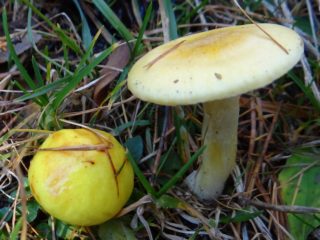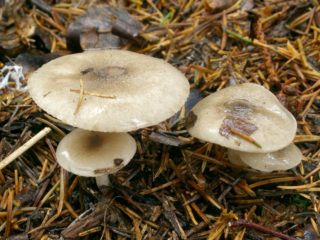Content
Gigrofor late (or brown) is not the most attractive mushroom in appearance, it looks very much like a toadstool or, at best, honey fungus. But in fact, its fruiting body is edible, it has excellent taste. Despite this, the hygrophor is collected only by experienced mushroom pickers, since few people know it.
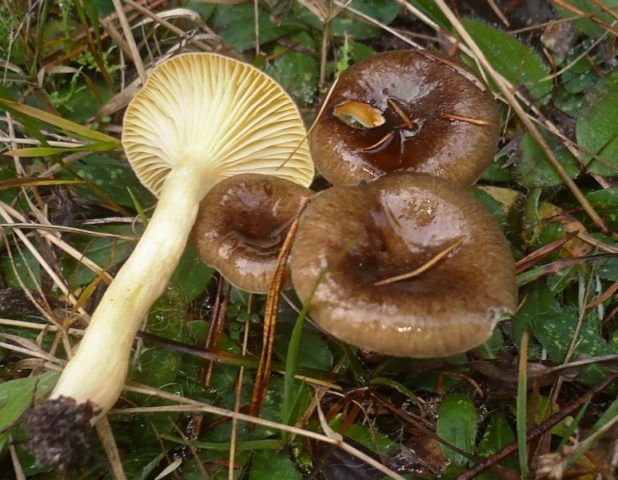
Gigrofor is also called brown because of its brown hat.
What does the late hygrophor look like?
Gigrofor late grows all autumn, right up to winter, sometimes all of December. Mushrooms are not located singly, but in large families or even whole colonies. Therefore, it is very easy to collect it, the main thing is to get to a fertile place. Only one such glade can carry a whole bucket.
Gigrofor looks like many poisonous mushrooms, but it has a number of distinctive features. The cap of the mushroom is brown, brownish, with yellowness along the edge. The middle is always darker. There is a bump on it. The size of the cap reaches 2-3 cm.
The plates are bright yellow, lemon-colored, rare and descending, as if adhered to the lower part of the fruiting body. All other types of hygrophors have pure white plates.
The leg also has yellowness, similar to that on the plates, sometimes reddish. Its thickness varies within 1 cm, height - up to 10 cm. It has an almost regular cylindrical shape, sometimes it can slightly expand downward.
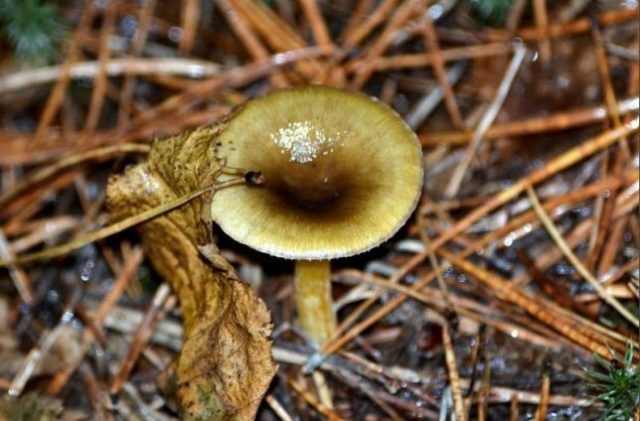
Grows in mixed or coniferous forests
Where does the late hygrophor grow
This type of hygrophor grows mainly in a pine forest, less often in a mixed one. They love mosses, lichens, and areas covered with heather. These mushrooms are late autumn. They grow when there are practically no other fruit bodies in the forest, right up to the snow.
The hygrophor may be slightly larger or smaller, depending on the soil on which it grows. But in any case, this mushroom is small in size. Due to the fact that it does not grow alone, but in large families, it is easy to collect it. In one trip to the forest, you can quickly collect a bucket of mushrooms.
Fruiting in August-November. Under favorable weather conditions, it grows in the forests throughout December, until the new year. It is not afraid of frost and can be collected up to the first snow. Many mushroom lovers succeed in growing a late hygrophor not only in the country, but even in an apartment.
To get a harvest at home, you must meet a number of conditions:
- purchase spore powder at a specialized point of sale;
- in open ground, planting is carried out near fruit trees, in the middle of spring, loosen the soil by 10 cm, dig holes and put sand with spores in them (5: 1), cover them with a layer of soil or humus, ensure abundant watering every 2-3 days ;
- choose a place in a cellar, basement or any room where it is possible to maintain high humidity, the required temperature and air circulation.
To grow a hygrophor at home, you need to prepare a suitable substrate.Mix: dry straw (100 kg) + manure (60 kg) + superphosphate (2 kg) + urea (2 kg) + chalk (5 kg) + gypsum (8 kg). First, soak the straw for several days, then transfer it with manure, simultaneously adding urea and superphosphate. Water it every day for a week. Then mix all the layers and do it every 3-4 days. 5 days before the end of compost preparation, add gypsum and chalk. Everything will take a total of just over 20 days.
Then put the finished mass in bags, boxes. After a few days, when the temperature of the compost becomes stable at the level of +23 - +25, plant the spore powder, placing the holes in a checkerboard pattern at a distance of at least 20 cm from each other. Cover with a substrate on top, water abundantly. Maintain high humidity indoors. When the first spider web of mycelium appears after 2 weeks, grind it with a mixture of limestone, earth and peat. After 5 days, reduce the room temperature to +12 - +17 degrees.
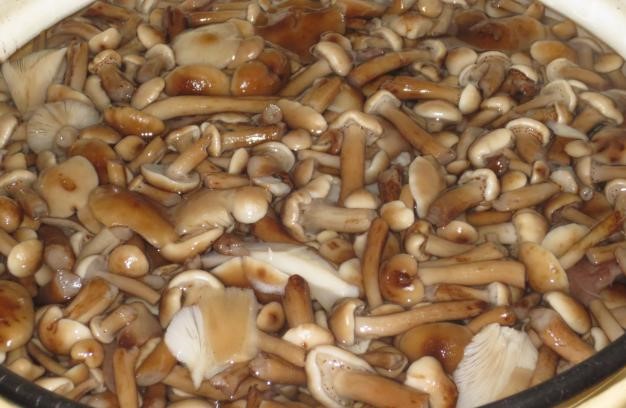
The hygrophors must first be boiled, but you can also fry immediately
Is it possible to eat a late hygrophor
Gigrofor late is very similar in appearance to a toadstool. But in fact, this is a very tasty mushroom, suitable for all types of preparations. It can be salted, pickled and even frozen for the winter. A very tasty soup is obtained from the hygrophor. There are two ways to fry in a pan: with and without preliminary boiling. Opinions differ among mushroom pickers, but mushrooms are tasty and edible in both cases.
It takes no more than 15-20 minutes to cook the hygrophor. At the same time, it turns out to be a little slippery. Then lightly fry and that's enough. You don't need to add any spices other than salt. The mushroom is very tasty, it is not without reason that it is also called sweet. Hygrophors contain a lot of nutrients, protein. This is what determines their high taste. Here is some of them:
- vitamins A, C, B, PP;
- trace elements Zn, Fe, Mn, I, K, S;
- amino acids.

There are different types of hygrophors, but the later ones can be immediately recognized by the brown hat and yellow plates.
False doubles
Hygrophoric mushrooms are of different types, but they all belong to conditionally edible mushrooms. There are no poisonous among them. Some types are widely used in folk medicine due to their high antibacterial activity, beneficial effects on the entire body.
The deciduous hygrophor is most similar to the brown (late) species. But the double has a lighter color of the cap. On this basis, they can be distinguished.
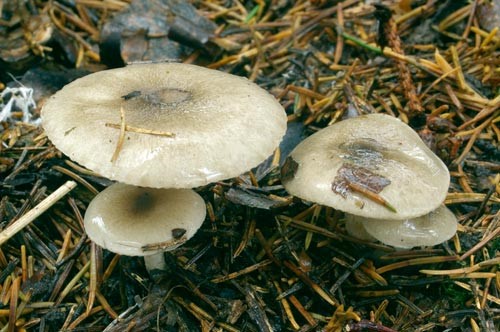
Both mushrooms are edible, so they are often collected together as one species.
Gigrofor is easy to confuse with a false estimate. They are very similar, and the danger is that the double is poisonous. As a rule, the cap of a false mushroom is painted in brighter, flashy colors. In the hygrophor and the real honey fungus, they are more muted brown.
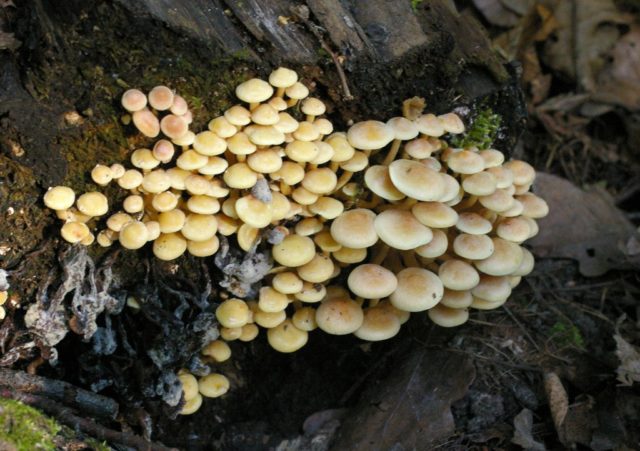
Poisonous mushrooms almost always have a very unpleasant odor.
Collection rules and use
Gigrofor late is a very fragile mushroom. Therefore, it must be folded very carefully into a basket or bucket. During collection, the lower part of the leg with the ground should be cut off so that the mushrooms are clean, without excess debris, which is very difficult to get rid of later. Gigrofor is often wormy. This should be monitored and only strong, whole mushrooms should be taken into the basket.
Conclusion
Gigrofor late is a little-known edible mushroom that has excellent taste. It grows until late autumn, when there are practically no other mushrooms in the forest. Suitable for any culinary treatment, is not poisonous, does not taste bitter, has an excellent taste.

